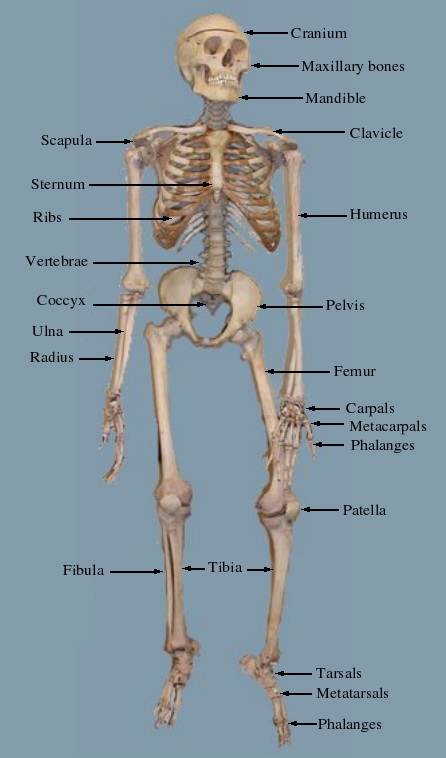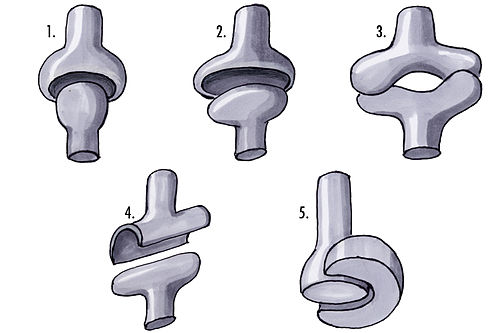Difference between revisions of "AY Honors/Bones, Muscles, and Movement/Answer Key"
| Line 27: | Line 27: | ||
[[Image:Labelled_skeleton.png]] | [[Image:Labelled_skeleton.png]] | ||
| − | + | This image shows all the bones listed above. It should be noted that the maxillary bones are the bones of the face. Also note that the ulna connects to the humerus and is larger than the radius. The radius connects to the ulna. The phalanges are both the finger bones and the toe bones. | |
=What is a joint?= | =What is a joint?= | ||
Revision as of 02:48, 3 December 2005
What's the difference between exoskeletons and endoskeletons? Which type of skeleton do humans have?
An exoskeleton is a hard shell on the outside of a creature (such as an insect or a lobster). An endoskeleton is the system of bones on the inside of a creature (such as a human, dog, cat, or a bird).
List three functions of the skeletal system.
The skeletal system provides support to a body. Without a skeleton, a creature would be a shapeless blob. The marrow inside bones produces blood cells. The skeletal system protects the internal organs from physical harm. Bones serve as a place where the body can store minerals for later use. Bones also serve as levers against which the muscles pull to accomplish motion.
Is bone a living tissue? Explain why or why not.
Bone is living tissue. Were it not so, it could not produce blood cells, nor could bones heal after being broken. Bones cells continually regenerate themselves.
Describe the structure and development of bone.
Identify the following bones of the skeletal system.
Carpals, clavicle (collar bone), coccyx (tail bone), cranium, femur, fibula, humerus, mandible, maxillary bones, metacarpals, metatarsals, patella, pelvis, phalanges, radius, ribs, scapula (shoulder blade), sternum (breast bone), tarsals, tibia, ulna, and vertebrae.
This image shows all the bones listed above. It should be noted that the maxillary bones are the bones of the face. Also note that the ulna connects to the humerus and is larger than the radius. The radius connects to the ulna. The phalanges are both the finger bones and the toe bones.
What is a joint?
A joint is the place where two bones come into contact with one another.
List three types of joints found between bones.
Fibrous joints are where the bones are connected together by a fibrous connective tissue. These joints allow for little to no movement. An example of fibrous joints are the joints between the various bones in the cranium.
Cartilagenous joints are connected by cartilage. These joints allow for little movement. An example of a cartilagenous joint is the joint between the ribs and the sternum.
Synovial joints are seperated by an empty space called a synovial cavity. These joints allow the most movement. Examples of a synovial joints are the elbow and the knee.
Name and describe six types of freely movable joints. Be able to locate an example of each of these in your body.
- Ball and Socket joints can be found in the hip. These joints allow for movement in many directions.
- Ellipsoid joints can be found in the knee. When the knee is extended, it does not allow rotation. When it is flexed, it allows for limited rotation.
- Saddle joints can be found in the fingers and thumbs.
- Hinge joints can be found in the elbow between the humerus and the ulna. A hinge joint works just like a door hinge, allowsing motion in only one direction.
- Pivot joints can also be found in the elbow between the ulna and the radius. This type of joint allows one bone to rotate about the other.
- Gliding joints can be found between the carpals in the wrists. These joints allow limited movement between the bones as one glides past the other.
Be creative and construct a model of one of the six freely movable joints.
Approaches to constructing a model include:
- Form the bones with clay and then let them harden.
- Cover wooden dowels with paper mache.
- Make a wire frame and cover that with paper mache.
- Carve bones out of soft wood (such as balsa or pine).
- Make an impression in wet sand and fill with plaster.
- Make cross-sections out of paperboard and glue them together.
- Make the bones from sugar cookie dough and then bake them.
Be sure to review requirement 17 before starting. It's important to know how this model will be used during the design phase.
What is another name for a broken bone? List 3 types of breaks that can occur in bones. Describe how bones heal and how doctors can help this process.
Another name for a broken bone is "fracture." There are two main types of fractures, open and closed. In an open fracture (also called a compound fracture), the bone protrudes through the skin. This is a very serious condition as it allows infection to enter the body. In a closed fracture (also called a simple fracture), the bone stays inside the body.
Sub-categories of fractures include:
Transverse - the break in the bone is at a right angle to the long axis of the bone.
Comminuted - the bone breaks into three or more peices.
Greenstick - the bone breaks on one side, and the other side is bent. This is very similar to what happens when a green twig is snapped: it doesn't come all the way apart, but it is clearly broken on one side.
Stress - a hairline crack in the bone. The bone does not separate into two pieces.
Living bones are in constant change. Cells die and are replaced on a regular basis. Because of this, a bone will heal all by itself if allowed to. Doctors can help this process in two ways. First, they can set the bone. This is done by making sure the pieces of the bone are aligned properly. In a comminuted fracture this may involve surgery. The second way that doctors help bones to heal is by immobilizing them - that is, keeping them from moving around. This can be done by surrounding the broken limb with a cast, or it can be done by embedding pins inside the body. Some bones do not need to be immobilized when broken (such as the nose).
What is osteoporosis? Who can get it? List at least 5 health habits that deal with maintaining healthy bones and muscles.
Osteoporosis is the depletion of minerals from the bone. Minerals in bones give them their strength, so a bone with a low bone mineral density (or BMD) is more susceptible to breakage, even when stressed only lightly. Anyone can get osteoporosis, but it is more common in postmenopausal women. Some of the risk factors of getting osteoporosis cannot be reduced by modifying behavior (such as being a woman, having dementia, having a family history of weak bones, or being of European descent), but other factors are easily avoided by healthful living. These health habits include:
- Avoid soft drinks, especially those containing phosphoric acid.
- Avoid alcohol.
- Avoid tobacco.
- Maintain a healthy body weight. Those with abnormally low body weight are more susceptible to osteoporosis.
- Make sure your diet has plenty of calcium.
- Make sure your diet has plenty of vitamin D.
- Get plenty of exercise.
What is the function of the muscular system?
The muscular system is the system in humans and in animals that facilitate motion. This motion can be either internal (a beating heat) or external (walking).
Name and describe three types of muscles tissue, Give one example of each.
- Cardiac muscles are found only in the heart. These muscles are what make your heart beat. Cardiac muscles are the only muscles in the body consisting of branching fibers.
- Skeletal muscles are attached to the skeleton and are responsible for voluntary (and sometimes involuntary) bodily movement.
- Smooth muscles are responsible for internal, involuntary (and sometimes voluntary) movement of the organs such as breathing and moving food through the digestive tract.
Be able to identify the following muscles on your body:
Masseter, Trapezius, Deltoid, Pectoralis, Biceps, Abdominal, Quadriceps, Triceps, Latissimus dorsi, Gluteus maximus, Hamstrings, Gastroenemius, and Soleus.
Describe the process that causes a muscle to contract.
Describe the difference between voluntary and involuntary muscles.
Using your model in #9, show how muscles, bones, and joints work together to produce movement.
Use rubberbands or elastic as muscles. Stretch them such that the joint can be moved by hand and then snap back into position when the rubber band (muscle) contracts.
If you use cookie dough, you may have a hard time keeping the bones from breaking. You may wish to form the dough around something a little more substantive, such as a dowel, a stick of celery, or perhaps a carrot. In this case you may use Twizzlers as muscles. Although they will not contract, they look kind of like muscles and taste pretty good.
If you use clay, plaster, or paper maché, be sure to make anchor points for the muscles before the "bones" harden. Try using cup hooks or eye hooks for this purpose. If using a wire frame, you can make the anchors out of the wire.
Find 3 texts in the Bible that mention bones and/or muscles. Tell about each one in your own words.
Note: In many translations of the Bible, the term "flesh" is used to describe muscles. Here are several passages featuring bones and muscles. Encourage your Pathfinders to look through more than the required three verses. It will be easier for them to describe the passage in their own words if they have made a connection with the verses.
- Genesis 2:21-24
- Exodus 12:46
- Job 40:16
- Job 10:10-12
- Psalm 22:14
- Ezekiel 37:1-12
- John 19:36
- Psalm 139:13-16


